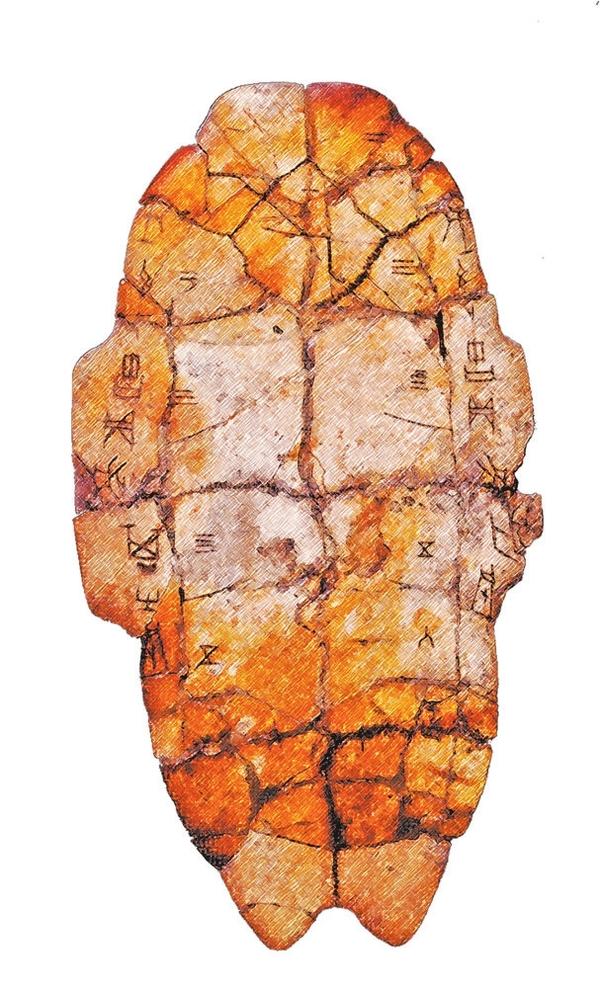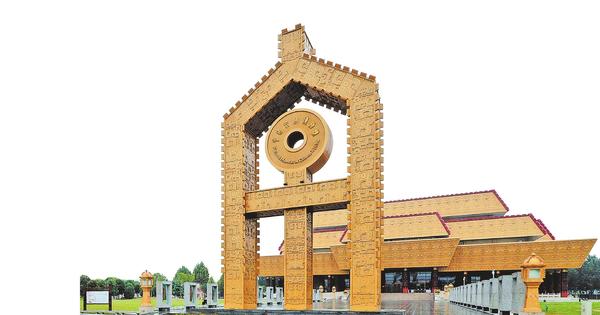Editor's note: A piece of oracle bone amazes the world. The unearthing of oracle bones in Yin Ruins of Anyang helps to extend the recorded history of China by about 1,000 years. The oracle bone inscriptions, engraved on tortoise shells or animal bones, are the earliest, most complete, most systematic, and most expressive form of writing ever discovered, and they are the origin of Chinese characters. Chinese President Xi Jinping pointed out during his inspection tour of Yin Ruins that Chinese characters are remarkable, and the formation and development of the Chinese nation cannot be separated from the preservation of them." The oracle bone scripts are remarkable; however, a complete set of characters to express the meaning of "remarkable" or "extraordinary" haven't been found in the oracle bone inscriptions. It is true that only about one-third of the approximately 4,500 oracle bone characters discovered so far can be interpreted, which may seem incredible. Still, it is precisely the charm of Chinese characters.
Throughout history, most new knowledge and disciplines have emerged due to discoveries. So, starting today, Henan Daily has launched a heavyweight series of reports titled “Remarkable Oracle Bone Inscriptions” to promote the innovation and development of Chinese civilization. The series logo is elaborately designed as a white seal, imitating the arrangement of oracle bone inscriptions. According to the "Yin Qi Wen Yuan," an oracle bone inscription big data platform, of the seven characters on the seal, the characters “不” (bù),“起” (qǐ), “甲” (jiǎ), and “骨” (gǔ) are in oracle bone inscription, while the remaining characters are in small seal script (小篆). The small seal script was simplified by Emperor Qin Shi Huang on the basis of the original big seal script (大篆) after he unified the six states as the standardized form of Chinese characters. Although the font is not unified, the style is harmonious, implying the inheritance of Chinese culture and Chinese character genes. Please stay tuned.
Shang Dynasty oracle bone unearthed from the Yin Ruins [Photo/Henan Daily]
The oracle bone scripts are undoubtedly the most precious cultural relics unearthed in the Yin Ruins of Anyang City. The National Museum of Chinese Writing recently announced the "Second Batch of Excellent Achievements in Deciphering Oracle Bone Inscriptions." The researchers on the list can receive up to 100,000 yuan for identifying new characters.
Oracle bone inscriptions are independent and systematic writing. According to statistics, more than 4,000 single characters of oracle bone inscriptions have been discovered so far, and only one-third of them have been deciphered by consensus. Why is the process of decoding oracle bone inscriptions so slow? How difficult is it to translate an oracle bone script?
"The first step in deciphering oracle bone scripts is to collect all the oracle bone materials and list all the entries. This work will give a rough direction for decoding the character, such as whether it is a verb or a noun. Once a general range is determined, a comprehensive examination of the character's form, pronunciation, and meaning is conducted, comparing it with other words that may match. Finally, the conclusion is verified in the oracle bone inscriptions," said Prof. Zhou Zhongbing from the Institute of Ancient Books at the School of Archaeology at Jilin University. He added that all the undeciphered inscriptions are "hard nuts."
National Museum of Chinese Writing [Photo/Henan Daily]
This time, Zhou Zhongbing won the first prize in "Reward Order" with his explanation article - “The Examination of 臺 among 仆臣臺 Seen in the Excavated Documents.” One of the oracle bone scripts she deciphered is a symbol that consists of two stacked "臣" (courtier) and a "子" (son) on the right. The answer Zhou gave is "臺" (the transitional Chinese character for "台").
The word "臺" is an ancient appellation for enslaved people. How can the oracle bone inscriptions of two "臣" and a "子" be linked to "臺"? The paper by Zhou is the first complete explanation of this character from multiple perspectives of its shape, sound, and meaning.
As a term used to refer to a low-status slave, the character "臺" has numerous examples in surviving historical texts. However, in excavated documents, there are currently only four known instances of its usage, making it quite rare and uncommon in the academic community’s understanding and interpretation. On the contrary, the words '臣' and '仆,' with similar meanings to '臺,' are used in many cases in the excavated documents. Does this asymmetrical phenomenon genuinely reflect the actual usage of the characters 臺, 臣, and 仆 in the unearthed documents?" At the beginning of the paper, Zhou raised a question.
Zhou then theorized that some characters used as “臺” in the oracle bone inscriptions and bronze inscriptions had not been accurately interpreted in the past.
"On the left side of this glyph are two "臣" overlapping, so its original meaning should still be considered with "臣." "臣" is the form of vertical eyes, meaning to open the eyes for an attentive look, and two "臣" means two vertical eyes, showing more concentration. So, he believed it should be the original character of '眙' in the "Analytical Dictionary of Chinese Characters" (Shuo Wen Jie Zi, the first Chinese dictionary that analyses the forms and origins of Chinese characters). The word '眙' can be inferred from '台,' so those characters in the oracle bones and bronze inscriptions are the interchangeable words of '台'" said Zhou.
To decipher this character, he started collecting materials in 2016. It took him two years to form the initial draft of the paper, not including the previous years of research.
The difficulty in deciphering the oracle bone inscriptions also lies in the need for more available references. Zhou explained that oracle bone inscriptions were the records of divination in the Shang Dynasty and were special. They are not real ancient books, and there needs to be more relevant information on the handed-down documents. Moreover, oracle bone inscriptions are so far from the present time, and the historical materials of the Shang Dynasty are so few and scattered that people know little about the social history of the Shang Dynasty, "which increases the difficulty of research and deciphering those characters," said Zhou.
The interpretation of oracle bones requires scholars to have long-term training in ancient Chinese characters and to read and understand the ancient books, especially relatively close to the oracle bone scripts era so that the oracle bone scripts and the handed-down documents can be mutually verified. Researchers willingly devote several years of effortto deciphering a single character, and they find great pleasure and satisfaction in this pursuit.
"It is difficult to interpret oracle bone inscriptions, and what is even more challenging is the need to sit on a cold stool and put in a lot of effort," said Jiang Yubin, a researcher at the Center for Research on Chinese Excavated Classics and Paleography in Shanghai's Fudan University. He once said it was challenging for scholars to make breakthroughs without interest and perseverance.
"I often feel excited about deciphering a difficult word or solving a complex problem. As a teacher of the younger generation, I have the obligation and responsibility to give full play to my abilities,” said Professor Li Chuntao from the Institute of Ancient Books at the School of Archaeology at Jilin University, who has received the second prize in the “bounty notice” of the National Museum of Chinese Writing.
"Chinese President Xi Jinping sent a congratulatory letter on the 120thanniversary of the discovery and research of oracle bone inscriptions. According to the letter, oracle bone inscriptions are considered the origin of Chinese characters and represent the oldest fully-developed system of characters discovered in China so far, and are the roots of fine traditional Chinese culture that merits even better preservation and development,” said Zhou. He added that unlocking the secrets of the inscriptions can allow people to gain a deeper understanding of the development of ancient Chinese society and culture and can provide more precious materials for historical research.




